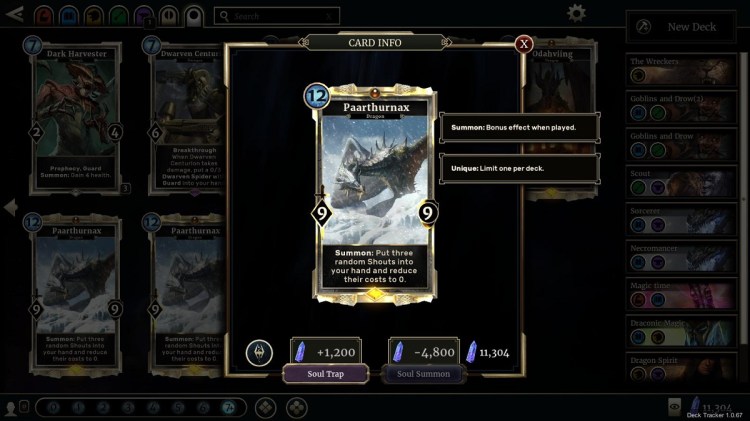Daenerys Targaryen wishes her dragons had an iota of the power that my draconic minions show in The Elder Scrolls: Legends. Of course my wyrms are beefy and fiery and soar over the battlefield. But they also make my foes quake in fear, reducing their power or shackling them to the battlefield upon which they stand. They buff my troops, giving them amazing powers. And they even destroy every other soldier in play.
Even mighty Drogon looks weak in comparison.
Dragons came to Bethesda’s The Elder Scrolls-based card game, Legends, in June with the Heroes of Skyrim expansion, and it didn’t take long before they “wrymed” their way into many players decks. They are powerful, as are many of their companion cards. I’ve been playing nearly every day since the set’s release, and I’m enjoy how Legends presents a different take on “wizard poker” than what we see from Blizzard Entertainment’s Hearthstone, another game I play almost daily.
But I wondered if why all these dragons were coming to Legends now. This is the first expansion set, after all. Bethesda’s Pete Hines, its vice president of public relations and marketing and a passionate collectible card player, said that the Skyrim set was a natural fit.
June 5th: The AI Audit in NYC
Join us next week in NYC to engage with top executive leaders, delving into strategies for auditing AI models to ensure fairness, optimal performance, and ethical compliance across diverse organizations. Secure your attendance for this exclusive invite-only event.
“Well, it was the only one where we could do dragons, because it’s Skyrim, and in the other ones dragons don’t exist in those timelines,” he said.
But then he got serious about the design decisions behind this parade of dragons. Along the way, we also broke down The Elder Scrolls Legends’ recent debut on smartphones, card design, and how Bethesda approaches changes (aka nerfs) — how, and when, do the needs of the many outweigh the fun of the few.
Here is an edited transcript of our interview.
GamesBeat: Why was this expansion the one for dragons?
Pete Hines: Skyrim as a setting was something we talked about doing a lot, even before the core set, when we were talking about the timeline and setting and mechanics and creatures and all of that. This is years ago. We kicked around Skyrim a bit and ultimately decided we were going to do something that was a little less specific to a particular game, and do deeper, game-focused dives as part of stories or expansion sets. This was the one we were most excited about doing, not just because of dragons, but because of shouts and some of the other things we could do: Imperials versus Stormcloaks. We targeted this one for a long time as the first one we wanted to do to really mix things up.
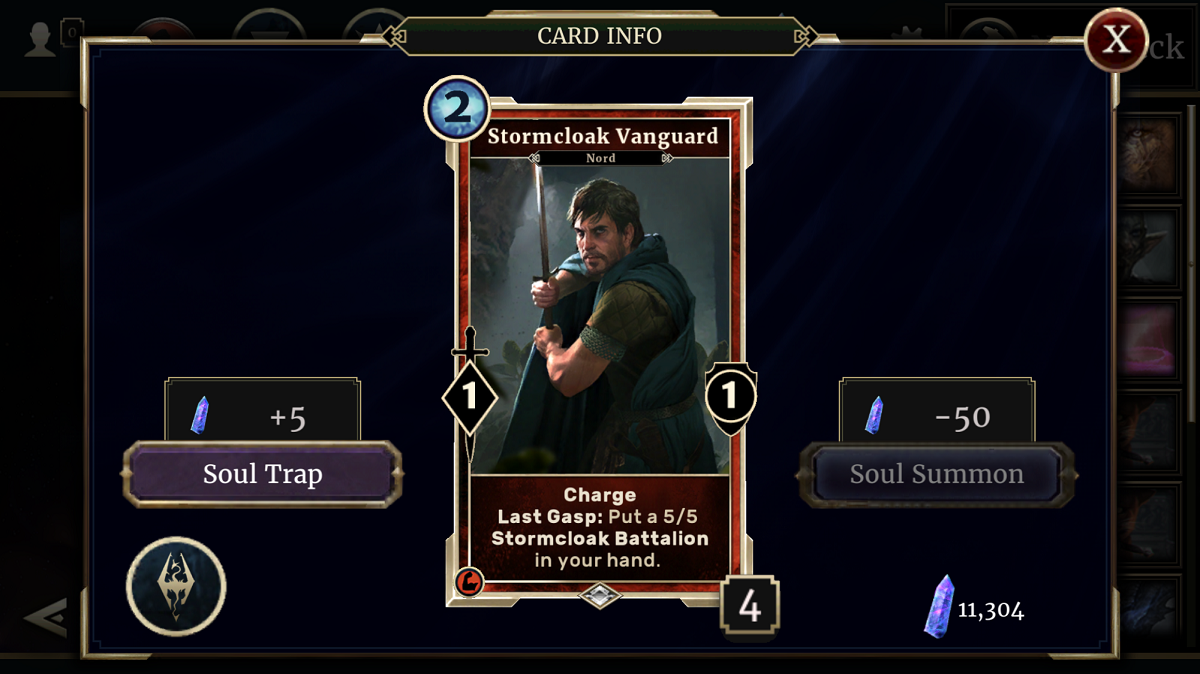
Above: The Stormcloaks are part of the flavor of Heroes of Skyrim.
GamesBeat: When you talked about Imperials versus Stormcloaks, it’s funny, as I’ve approached this set with my decks, I haven’t even started mixing and matching those. It’s been all about dragons.
Hines: Right. It’s not a main theme. It’s one of the underlying themes going on. Like the werewolves. There’s not 50 different werewolf cards, but it’s a subtheme going on in the set as we support some of these different tribal themes. Stormcloaks and what their mechanic is, obviously Imperials were a thing in the main set. But we want to continue to explore some of these. You probably noticed there are some more orc tribal things going on. A whole bunch of smaller sub-themes going on.
But obviously, dragons and shouts is the big one, because it’s cool and fun and different. It not only brings new card types, but also deck types. There’s a lot more graveyard matters decks now than there used to be, for example.
GamesBeat: I was going to ask about the graveyard. It’s one of my favorite mechanics in the game.
Hines: It’s pretty heavily influenced, I think. I haven’t specifically asked this question of the design team, but if you look at who’s on our design team, between—after Paul Dennen, you look at guys like Kevin Spak and Matt Nass. A whole host of guys who are known for playing Magic. The graveyard mechanics in Magic have been pretty big over the years, and I think probably had some amount of influence around them doing those kind of mechanics in the game. We now have a card that’s essentially the Magic scry mechanic — look at the top card of your library and either decide to keep it on top or discard it, then draw a card. Again that’s not an exact mechanic from Magic, but it does feel like “scry one, draw one.” There’s some carry over and influence there.
GamesBeat: I know part of it just comes from the interests of your designers, but is it also a way to help Elder Scrolls Legends stand out from other card games that don’t play much with the graveyard, like Hearthstone?
Hines: We’re always looking for additional ways to distinguish ourselves, No. 1, and highlight the things we do that other games don’t do, for sure. But it’s also — and this is a bit more subtle — if you know the story of Skyrim and dragons and how all that works, that’s what was taking place in Skyrim. Dragons being raised from the dead, coming out of the graveyard. It wasn’t just dragons being born all over the place. Someone was going around raising them from the burial mounds and bringing them back to life. That plays into it as well.
GamesBeat: I’m not the best player. I’m Rank 7. I’ve reached as high as Rank 5. But more than a month into the expansion, I’d go a day of playing two or three hours and not see a dragon in an opponent’s deck. Are you disappointed that you don’t see more opponents playing with dragons?
Hines: No, I think it’s just down to people playing around and trying different things. At different ranks, you’ll see more or fewer dragons. Right now one of the decks I’m playing — if you had played me, you would have seen lots of dragons, because I have a dragons matter green-purple ramp deck. I used to love to play the green-purple scout ramp deck, and I completely morphed it and changed it.
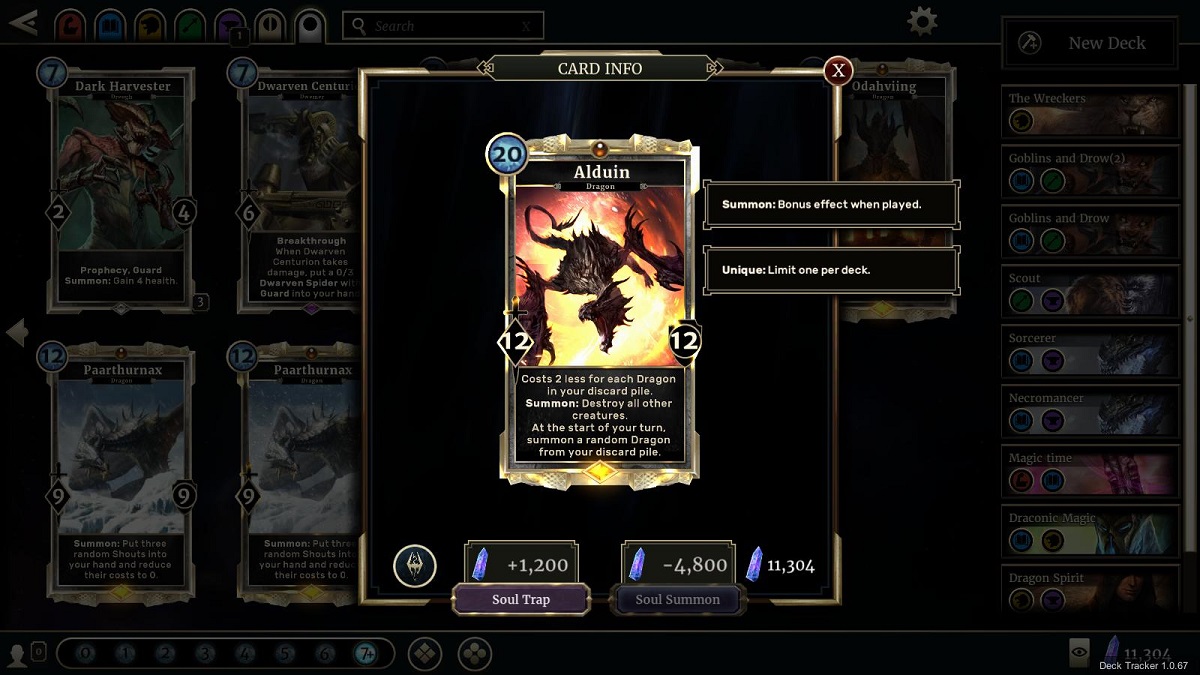
Above: Alduin is one of the most powerful dragons in Heroes of Skyrim.
I talked to a guy, Frank Lepore, who’s a very good Magic player. He’s done some content for us. He was telling me about his new version of it that he really liked, and it’s all about dragons. You’re ramping up to Alduin and Paarthurnax, playing ramp cards and lots of dragons and trying to get to high amounts of magicka to dump dragons on the board. You play Midnight Snack, because I care about making the dragons cheaper. Inevitably I have at least one of them in my hand. I can spill them out and not even care if I trade off and they die, because I’m trying to get them in the graveyard anyway, so Alduin is cheap enough to cast. He gets a lot cheaper if I’m really throwing dragons out there.
I’ve had a lot of success and a lot of fun with that deck, but I also play an Action-Assassin deck that Sam Pardee built. He’s another designer who’s also a terrific Magic player. He built this really interesting deck around zero-cost cards. It doesn’t have a lot of anything that anybody’s playing. I’m playing the stupid 1/4 Merchant’s Camel, but it’s all built around this idea of the market card that drains your opponent for one every time you play a zero-cost card.
I did it on the stream two weeks ago and people were like, “This is really cool and different. I haven’t seen anyone play Legends this way.” Usually they’re trying to play really cool action spells or big creatures, but I’m doing something completely different. I’m not going to do what you’re doing. I’m doing my own thing over here and making really interesting decisions about cards that I want to keep or throw away.
That’s the thing about our game that I really like. If everyone is playing dragons, dragons get less cool. What’s healthy about our game is how much variety and diversity you get. You’re not seeing any dragons, but yesterday all I played was dragons. I think that speaks well to—I’m not seeing the same decks. I’m not playing the same matches. I’m not always trying to deal with the same cards. That’s good for us.
GamesBeat: That’s one of my favorite things about ESL. I’m not always playing the metagame same decks against the same decks, which I get really tired of in Hearthstone.
Hines: Beyond that, it’s actually something I debated with Paul Dennen for a long time. As usual, he’s always right. I asked him about deck size, because I was worried about inconsistency there. You’re just not seeing your cards. He said, look, that’s what I’m going for. I want it to be the case that you can’t just build a deck around a card you have three copies of and reliably hit it all the time, in every match. That makes for much for predictable, boring matches. I want it to be less likely. I want you to have to play more cards, to add more variability in terms of what you’re going to draw.

Above: When this card works, it can be devastating.
The card I was thinking of at the time was Dres Tormentor. It’s the 3/4 blue card, when a creature gets shackled–I tried to build a Dres Tormentor teck, but if you don’t get Dres Tormentors on the battlefield, the deck did almost nothing. He said, that’s the point. Your deck can’t just be, I draw this card, and I go off. Because of the size of the deck, you have to put more cards in and have more than one way to win.
It turns out that was a smart decision, as usual from Paul, and something that makes our game really healthy.
GamesBeat: How challenging was it to design dragons for this set that fit all of the colors?
Hines: That’s not something I’m as intimately involved in. By the time it gets to me they’ve figured out a lot of that stuff in terms of what they’re doing mechanically. But when you look at what the dragons are doing, they fit nicely into the themes you expect in those colors. The blue dragon, the Lookout, it’s not just about dragons, but it’s also about cards that care about dragons. In blue you have Ghost Sea Lookout, which is part of this cycle of cards that are Lookouts, creatures that are looking out for dragons. Each one does something different. Green does life gain when a dragon is played because that’s a mechanic you’re used to seeing in green. Blue does ward because blue has a lot of ward in it. Or a card like Dragon’s Fury, the action that does additional damage for each dragon. Blue is used to have actions that deal damage. That’s the color that has lightning bolts and fireballs.
I don’t think the balance part of it was tricky. Each color lends itself pretty well to what dragons would be about and be doing. The Lookout in purple spews out guards because purple is known for having guards and getting in the way and clogging up the board. Each of them fits nicely with what’s going on in those colors. The purple dragon helps you gain magica and the Lookout puts down guards, which leans more toward control decks and ramp decks, which makes sense, because that’s what you see in those colors.
GameBeat: What’s been your favorite dragon to play with so far?
Hines: The Shearpoint Dragon, the 4/4 for 6 magicka, and it gives a creature -2/-2. If you reduce a creature’s power or health because of some other effect, it reduces by an additional one. A 4/4 for 6 is not a great deal. You can get much bigger creatures for 6. But coming in and being able to immediately get rid of something with ward, a lot of times that shrinks down another creature such that you can trade with it. The fact that it stacks with other Shearpoint Dragons and can take something and reduce it even more when you have reducing effects – which green tends to do, with cards like Curse that give -1/-1 – that’s been a really fun, interesting.
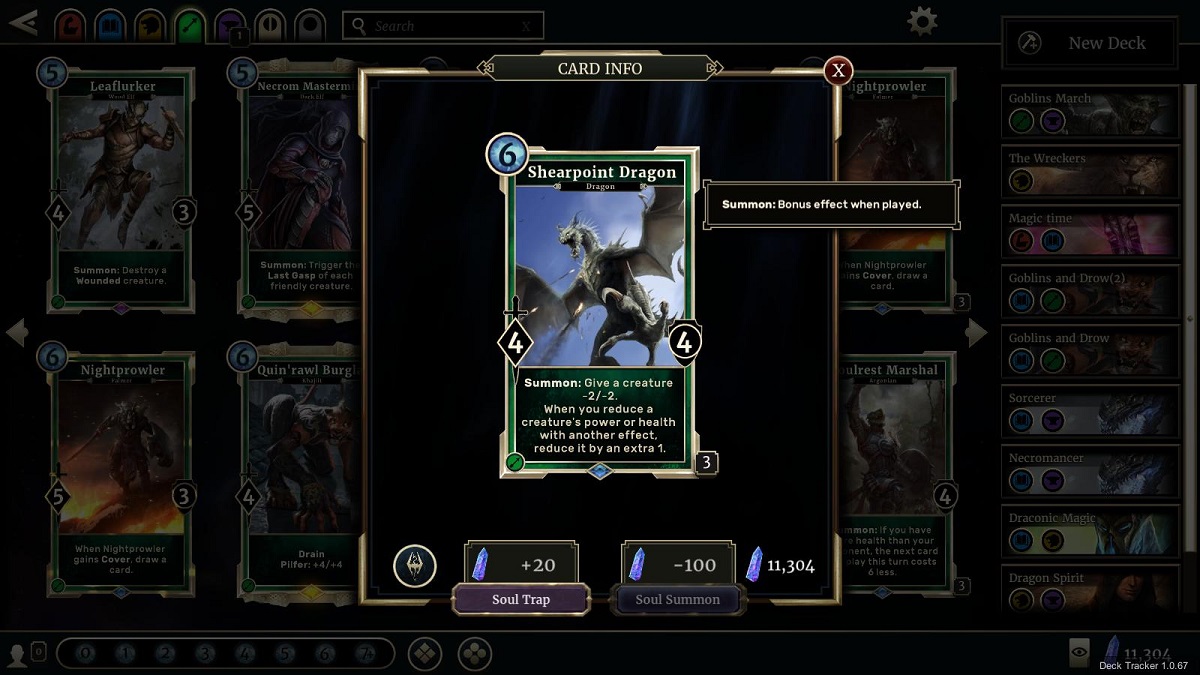
Above: “Your powers are weak, old man.”
Truthfully, the most fun one is Alduin, because he’s a 20 magicka giant thing. He’s the top end of my dragon ramp deck. Dropping a 12/12 that blows up the world and starts randomly summoning dead dragons from your graveyard — there’s a reason why he’s a unique. More than one of him would be broken.
GamesBeat: Yeah, he’s the favorite card in my blue/gold deck.
Hines: Dropping him down and having him do stuff—it’s not like he’s invincible. There’s any number of ways to kill him. But Soul Tearing, the action that lets you draw a creature from your discard pile—going and getting him back and doing it again is just such a groan test from your opponent. Oh my god, I just killed that thing and it’s coming again. Summon more dragons. It’s pretty great.
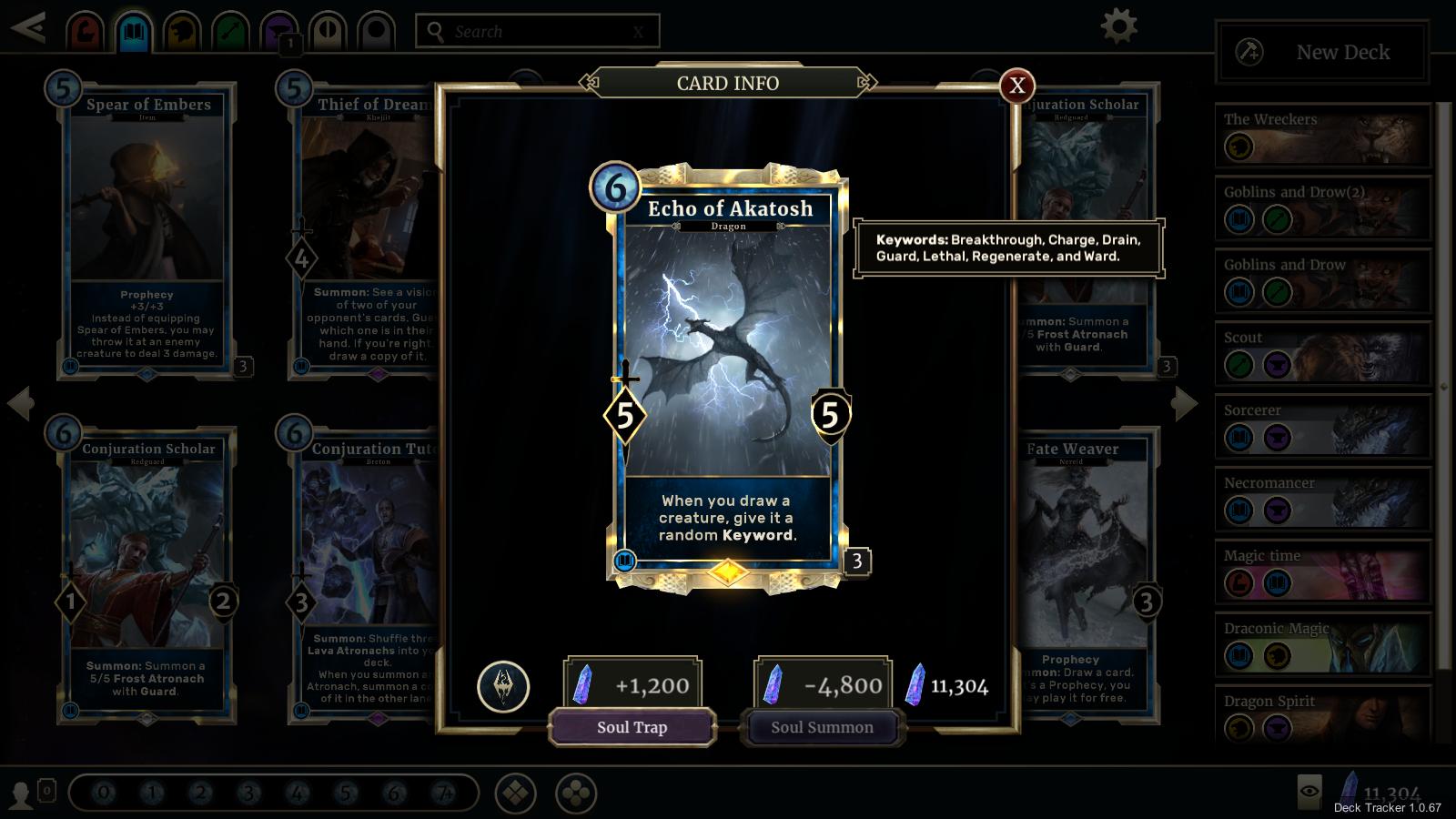
Above: Echo of Akatosh is a dragon that gave random effects to every card in your deck until a recent change.
GamesBeat: The first set of card changes hit the dragon Echo of Akatosh, my favorite card. Why did you just change it to the top card each turn, as opposed to your entire deck, and make it more expensive?
Hines: It’s for two reasons. No. 1, you don’t want to have a card that gets played have this massive ongoing effect even if it dies right away. A card like Alduin, or a card like Parthuurnax, or whatever it is, if you immediately Silence it or Piercing Javelin it and kill it, it hasn’t gone bonkers forever. But Echo of Akatosh, just by playing it, immediately did something to the rest of your deck forever that your opponent couldn’t do anything about.
It’s really more about interactability, which is something we try to lean into and highlight in Legends. The ability to play prophecies off runes that are broken on your opponent’s turn changes the strategy of the game and the way you sequence when you play your cards, and how you attack. Creating this ongoing effect for your deck that your opponent can’t interact with was a negative experience.
GamesBeat: Did that outweigh the fun people were having with that random effect?
Hines: Yeah, but that’s the point. There’s other cards in the game that have a similar effect, but they only impact the cards on the battlefield at that time. Making every card in your deck more powerful by playing one card—it’s not a support that your opponent can silence or blow up. It was just, well, he did that, and now I can’t do anything about it. The problem in this case wasn’t that it was too powerful and it was breaking the meta, because it turned out, on the ladder, especially at the higher levels—folks figured out pretty quickly that while you’re doing that, you’re going to be dead before you draw any of those cards, because I’ll do this and this and this and then kill you. That’s how you deal with it. It was more of a player perception—not having a card that people simply didn’t feel good about. That’s important to us. Even if the actual power level wasn’t overpowered, the way people felt about it was such that we needed to adjust it and bring it more in line.
GamesBeat: It’s a case of my fun was ruining the fun of 20 other people.
Hines: Yeah, exactly. If the thing that you’re doing, your opponent can literally do nothing about it, that tends to create a less fun, less interactive game, which is not what we want Legends to be.

Above: The Elder Scrolls Legends’ mobile UI is slick.
GamesBeat: I like how the UI feels on the screen in the mobile version. I’ve even been able to build decks. It doesn’t feel as convoluted as in some other card games in the mobile version. How hard was it, and how long did it take you to come up with the UI for this?
Hines: Very and long. [Laughs] It’s exactly what you said. It’s iterating and reiterating. The UI is such a tough thing to get right. The relative size of the cards on the screen, fitting all of those on a battlefield, how you zoom in on them—it wasn’t as much of a technical thing, how we get this to run on these devices. That just isn’t as big of a deal anymore. It’s more about, if this is the only way I’m experiencing this game, can every single part of this feel okay? How many cards do we put on the deck collection screen when you’re trying to build a deck? All those things. Even just simple things like—you’ve probably noticed, between the phone and the PC, some buttons aren’t in the same place you expect them from the PC layout, because of some design choices we made. We need to move that somewhere else to allow more space, or to try to reduce the chance that you mis-click. You’re trying to look at your graveyard and you accidentally hit pass turn, well, that’s about as bad an experience as you can have. Figuring out the space that we need on a much smaller screen, and potentially moving things where folks aren’t used to it, but once you play it you understand why this is here and that is there now.
GB: I like how well it highlights what quests you have, your dailies, better on mobile than it does on the PC.
Hines: That’s actually a thing we’ve continued to try to iterate on with the PC version – how to better and better point folks toward where their quests are without them having to go check their character screen to see what they are. I just know I must have one for versus arena because I have a quest thing on it. Those things, we were doing them on PC in part with an eye toward the mobile release and trying to make that more accessible and easy to find. Again, you just don’t have the real estate. You don’t want people having to click 10 times to find a simple piece of info.

Above: It’s easy to build and edit decks in the mobile UI.
GamesBeat: Was that designed knowing that in the future, that’s how you wanted to engage with it on mobile?
Hines: Partially, but mostly, the underlying reason for that was, we just wanted the game to be built in such a way that, I don’t care what device you’re playing on. You’re just playing Legends as you. If you stop playing on that device and start playing on another one, the game picks up right where you left off. Even if you and I were playing right now on PC, and my client crashes, I can pull out my phone, boot up Legends, and pick up right where the PC game left off. The game doesn’t even really acknowledge what platform you’re connecting from. It just knows that you’re DCDeacon and this is where you’re supposed to be right now. Off you go.
GamesBeat: Lethal, where cards get an instant-kill mechanic, is my biggest frustration when it comes to Legends’ mechanics. I feel like too many people are playing it. Do you think it’s too much of the meta, or are you happy with where it’s at?
Hines: No, only because — I’ve faced a fair amount yesterday with my dragon deck, but I had a lot of ways to deal with it. You may or may not know, there’s a running gag I’ve had for two years now, which is that my favorite card in the game is still Fighters Guild Recruit. Which is not the best card in the game, but my mantra is that it really is the best card in the game. It’s only 2 magicka. It’s just a 1/2. But it has Prophecy and Guard, and most important, Lethal. It kills everything in the game, except when you look at it, there are lots of ways to deal with it pretty easily. You curse a Fighters Guild Recruit and a zero-power creature does no damage and therefore Lethal is irrelevant. I face off against decks with Ward, and my Lethal does nothing to those guys. They’re able to cheaply and easily get rid of it and still advance their game plan. Or Execute. Or Arrow Storm. There are lots of ways to deal with cards that have Lethal. It’s OK for a mechanic or a card type to be popular, so long as there are plenty of ways to deal with it.
I find, in a lot of ways, that Ward can be more frustrating and difficult to deal with sometimes, if you’re not prepared. They keep putting out creatures that you can’t kill because you have to get rid of the Ward first. But it’s also partially, for me, a bit of a mentality shift that I picked up a while ago playing across a number of card games, which is—there’s nothing inherently wrong with a card—sometimes people attribute too much value to, “Yeah, but I’m going to lose my card if I put it in front of that thing and trade.” But oftentimes you actually help the opponent out by not just saying, “Yeah, that’s gonna happen, so what?” You have to keep playing cards and advancing your agenda. The two-lane thing definitely helps. If Lethal was a mechanic and you could only play creatures right in front of that thing, you have a much bigger problem.
That’s one big reason for having two lanes. Regardless of what your opponent has on the board, you have some ability to play around. Someone puts down a Fighters Guild Recruit in the right lane, I just start putting stuff down in the left lane until I figure out what I want my answer to be for that. Sometimes I’m just going to find a cheap thing to trade with that and kill it. Sometimes I don’t have a choice. I’m going to play something a little more expensive and good for them, they killed my 4-cost creature with their 2-cost creature. But I’m not going to give them a considerable strategic advantage by continuing to play around a card just because of a keyword on it. Sometimes you have to make short-term loss, long-term gain kinds of decisions. We do pay a lot of attention to what’s being played, the construction of those decks. So long as there are good answers for stuff, I don’t think there’s any one card mechanic or deck out there that doesn’t have reasonable answers and ways to deal with it.

Above: The Elder Scrolls Legends’ Dr. Boom.
GamesBeat: One thing I’ve come to embrace about Legends is how flexible it feels. In my experience, few builds dominate the meta, though others do feel differently about control, ramp, and aggro decks. You can build a reasonable deck without having to netdeck. You can build a deck that’s unique and that will win some games. How difficult was it for your designers to come up with that flexibility?
Hines: Well, I think the initial design was really good, but the fact of the matter is, it took a lot of beta testing all through last year to get us to this point, and a willingness to go through and be responsive and change cards, whether it was—usually when people talk about the meta, they’re only talking about constructed meta, but there’s an arena meta that, for me, because I love playing limited, is super-important. I don’t want to just have to always draft this two-color pair because it’s the best deck in the game. I like that I can jump around and draft a lot of different kinds of decks and have them be viable, because that meta is also balanced. That has more to do with, a lot of times, changing rarities, how often a card can show up. We did a lot of that last year.
But it was mostly having the patience to continue to say—we’re going to continue to test, continue to balance. You have to put it in the hands of a lot of people, to see if they come up with things we hadn’t expected, or try to come up with these combos that are game-breaking. “Everybody should play this deck because it’s clearly the best.” We had this big gauntlet this weekend, our in-game tournament, and it’s interesting to see how many different decks people are talking about bringing to the gauntlet. That’s where we want it to be. You don’t always want to play the exact same deck. You don’t want to feel like every game plays out the same way because you’re playing the same cards. I like facing off with somebody who’s playing blue-yellow. I know they’re a mage, but I don’t know what kind of mage. I’ve played against blue-yellow decks that are super aggro, trying to kill you quick. I’ve played against control decks, actions matter decks.
There’s lots of different ways, even within two colors, that a deck can go, because of all the cards and the different synergies. Like you, I think that’s really healthy and good for the game.
GamesBeat: How challenging is it for The Elder Scrolls Legends to get noticed when Blizzard Entertainment’s Hearthstone dominates the category so much? Some Hearthstone pros seem to be dissatisfied, and they’re moving toward Gwent because they want something that has less randomness than Hearthstone does.
Hines: Certainly it’s difficult when you have any kind of competitor, regardless of the genre or style of game. If you have somebody who’s well-entrenched and dominant in terms of the number of players, that’s always going to be a real challenge. In a lot of ways, I feel like I’ve seen this movie before, because we had a lot of the same questions about Elder Scrolls Online. World of Warcraft is the dominant MMO, the 800-pound gorilla in the space, how do you make an MMO and compete? Here we are years later. We have 10 million people who have played the game. It’s going strong.
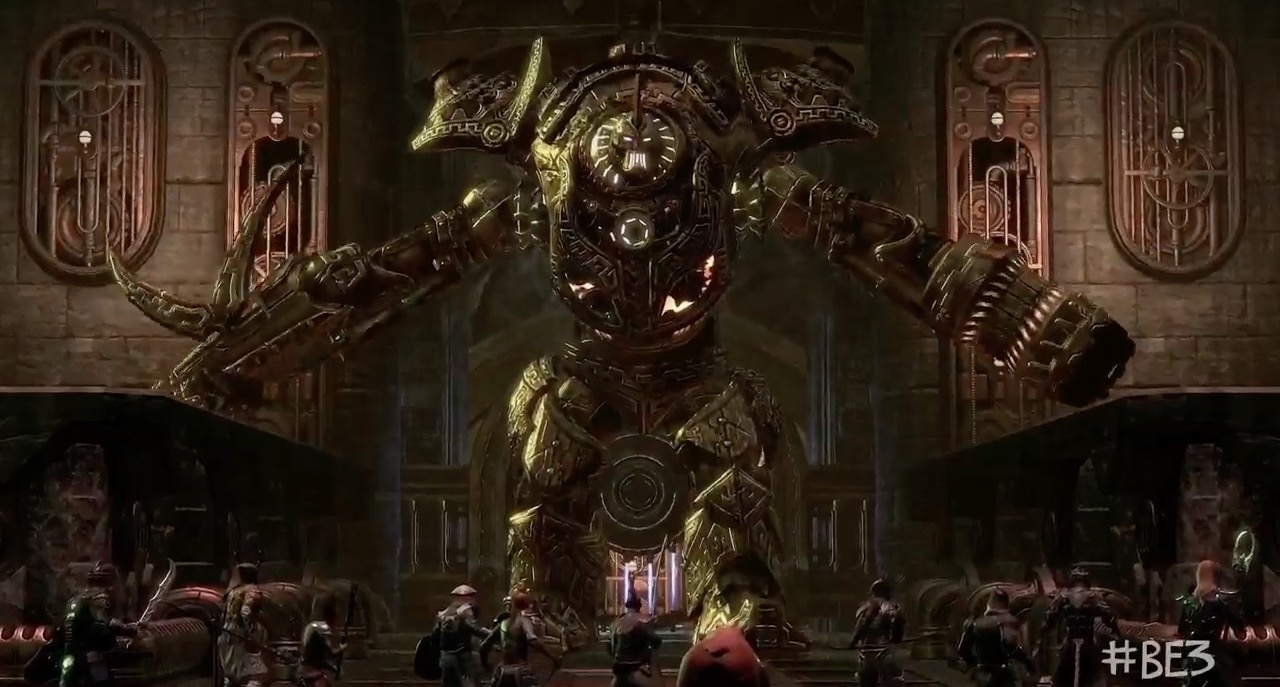
Above: Bethesda has faced Blizzard before with The Elder Scrolls Online.
I’m looking to take a lot of those same learnings to Legends, and have been, in terms of—look, I can’t control what other people do. I can only control what we do. If we have the willingness to put the time in and make the changes, listen to the community, try to highlight what’s different about our game and what makes it fun and special, then we have a chance to be successful. There’s no magic bullet. I’m not gonna roll out an initiative tomorrow that’s suddenly going to change everything. It’s about having a plan and sticking with it. For us, one of the biggest parts of our plan was the mobile version, because we had so many people saying, “Looks great, I was having a lot of fun, but I’m gonna wait to start when the mobile version comes out.” For us that’s why yesterday was such a big deal, and now it’s incumbent upon us to keep doing the kinds of things we’ve been doing, constantly making the game better and more fun. And, to your question, getting the word out there via PR and marketing. We’re doing a lot of things with sponsoring streamers and getting folks to stream the game and introduce it to their audiences. We’re doing stuff with Twitch drops, where people are rewarded for streaming or watching people stream Legends, to foster that sense of community and seeing how other people are playing the game and getting better. Things like in-game tournaments—esports is a thing we get asked about a lot from our more established players. We have some more info coming soon about stuff we’re going to be doing there.
But it’s not a sprint. It’s a marathon. Even with this launch, we’re really still just getting started.
